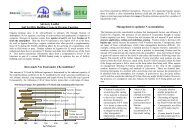A review of leguminous fertility-building crops, with particular ...
A review of leguminous fertility-building crops, with particular ...
A review of leguminous fertility-building crops, with particular ...
You also want an ePaper? Increase the reach of your titles
YUMPU automatically turns print PDFs into web optimized ePapers that Google loves.
A <strong>review</strong> <strong>of</strong> <strong>leguminous</strong> <strong>fertility</strong>-<strong>building</strong> <strong>crops</strong>, Defra project OF0316 3. How much N is captured?<br />
Italian ryegrass was found to be a more suitable control plant than either winter rape or winter<br />
rye (Mueller & Thorup-Kristensen, 2001).<br />
As in the example above, estimates may also be influenced by the method used to measure<br />
fixation. McNeill & Wood (1990) reported that values obtained using the N-difference method<br />
were approximately 25% lower than those estimated using the 15 N isotope dilution method.<br />
Similarly, under a high N regime, the N-difference method was found to underestimate the<br />
amount <strong>of</strong> fixed N in harvested clover material by up to 33% (Høgh-Jensen & Kristensen, 1995).<br />
Boller & Nösberger (1987), however, found that, on average, the difference method gave a 10%<br />
higher estimate <strong>of</strong> fixation than the isotope dilution method for mixtures <strong>of</strong> grass <strong>with</strong> either red<br />
or white clover. A study by Loges et al. (2000a) compared estimates <strong>of</strong> fixation by the Ndifference,<br />
isotope dilution and natural abundance methods for pure legume and grass/legume<br />
mixtures. Estimates using the isotope dilution method were between 89 and 104% <strong>of</strong> those<br />
obtained <strong>with</strong> the N-difference method, whereas estimates using the natural abundance method<br />
were only 52-61% those <strong>with</strong> the difference method. These values were based on sampling <strong>of</strong> the<br />
above-ground herbage. Differences between the methods were less marked (67-97%) when the<br />
calculations included below-ground plant components and changes in soil mineral-N.<br />
Nevertheless, it is clear that there are large uncertainties in any measurments <strong>of</strong> N-fixation.<br />
An additional limitation <strong>of</strong> these methods is that they are most suited to determining the<br />
accumulation <strong>of</strong> N in the above-ground parts <strong>of</strong> the plant. Few measurements include the N in<br />
roots and in stubble below sampling height. These components may be <strong>particular</strong>ly important in<br />
providing N to following <strong>crops</strong>. In the study by Loges et al. (2000a), estimates using the N<br />
difference, isotope dilution and natural abundance methods were on average 33, 46 and 75%<br />
greater when based on total plant material + soil mineral N than when based on just the aboveground,<br />
harvested material. McNeill et al. (1997) estimated that the total below-ground N for<br />
subterranean clover plants was equivalent to 73% <strong>of</strong> that in the shoots.<br />
Thus, much <strong>of</strong> the below-ground N can be present as fine roots and rhizosphere soil. It was<br />
concluded that standard root recovery procedures are likely to underestimate the total N<br />
accretion and turnover.<br />
Nitrogen-fixation has also been determined from the rate at which acetylene is reduced by the<br />
nodules when the gas is injected into the soil around the legume roots. The acetylene is reduced<br />
by nitrogenase in the nodules, the same enzyme responsible for the N-fixation reaction.<br />
However, this method is generally considered to be unsuitable for estimating the amount <strong>of</strong> N<br />
fixed during the season because <strong>of</strong> uncertainties about the exact equivalence between the Nfixation<br />
and acetylene reduction processes and the need to interpolate from a limited number <strong>of</strong><br />
short-term measurements. It is <strong>of</strong> greater value for comparative, short-term measurements <strong>of</strong><br />
relative rates <strong>of</strong> fixation: in these circumstances, results are more satisfactorily reported in terms<br />
<strong>of</strong> rates <strong>of</strong> nitrogenase activity.<br />
Methodological difficulties make it almost impossible to get an accurate measure <strong>of</strong> fixed<br />
N. All methods have advantages and disadvantages. The literature has used a number <strong>of</strong><br />
methods, so that estimates are not always directly comparable.<br />
Written by S Cuttle, M Shepherd & G Goodlass Page 46




